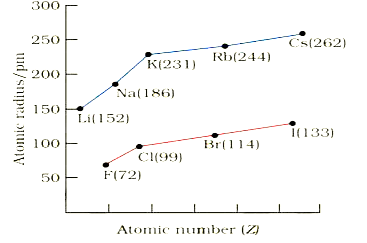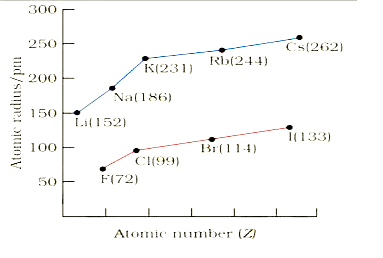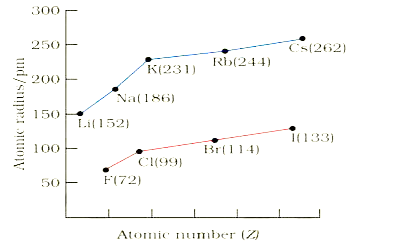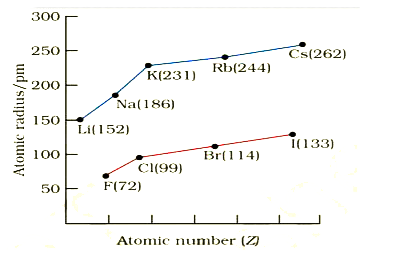Metallic Character
The ability of an atom to donate electrons and form positive ion (cation) is known as electropositivity or metallic character. Down the group, metallic character increases due to increase in atomic size and across the period, from left to right electropositivity decreases due to decrease in atomic size.
Non-Metallic Character
The ability of an atom to accept electrons to form a negative ion (anion) is called non-metallic character or electronegativity. The elements having high electro-negativity have a higher tendency to gain electrons and form anion. Down the group, electronegativity decreases due to increase in atomic size and across the period, from left to right electronegativity increases due to decrease in atomic size

Which of the following reason correctly justifies that “Fluorine (72pm) has smaller atomic radius than Lithium (152pm)”?
F and Li are in the same group. Atomic size increases down the group.
F and Li are in the same period. Atomic size increases across the period due to increase in number of shells.
F and Li are in the same group. Atomic size decreases down the group.
F and Li are in the same period and across the period atomic size/radius decreases from left to right
The correct Answer is:D
Step by step video, text & image solution for Metallic Character The ability of an atom to donate electrons and form positive ion (cation) is known as electropositivity or metallic character. Down the group, metallic character increases due to increase in atomic size and across the period, from left to right electropositivity decreases due to decrease in atomic size. Non-Metallic Character The ability of an atom to accept electrons to form a negative ion (anion) is called non-metallic character or electronegativity. The elements having high electro-negativity have a higher tendency to gain electrons and form anion. Down the group, electronegativity decreases due to increase in atomic size and across the period, from left to right electronegativity increases due to decrease in atomic size Which of the following reason correctly justifies that “Fluorine (72pm) has smaller atomic radius than Lithium (152pm)”? by Chemistry experts to help you in doubts & scoring excellent marks in Class 10 exams.
Updated on:21/07/2023Topper's Solved these Questions
- NEW CHAPTERS AND QUESTIONS BASED ON LATEST TYPOLOGIES INTRODUCED BY CBSE FOR 2021-22 EXAMINATION Book:OSWAL PUBLICATIONChapter:NEW CHAPTERS AND QUESTIONS BASED ON LATEST TYPOLOGIES INTRODUCED BY CBSE FOR 2021-22 EXAMINATION Exercise:CARBON AND ITS COMPOUNDS (VISUAL CASE - BASED QUESTIONS)
Explore 15 Videos
- METALS AND NON-METALSBook:OSWAL PUBLICATIONChapter:METALS AND NON-METALSExercise:Board corner(Long answer type questions)
Explore 20 Videos
- NTSE 2019 - 20 Book:OSWAL PUBLICATIONChapter:NTSE 2019 - 20 Exercise:(CHEMISTRY) ATOMS AND MOLECULES (STAGE - 2)
Explore 1 Video
Similar Questions
A homologous series is a series of organic compounds which belong to the same family i.e., possess same functional group) and show similar chemical properties. The members of this series are called homologous and differ from each other by the number of CH2, units in the main carbon chain.
The chemical properties of which of the following compounds is similar to the butane?
View SolutionMetal X is found in nature as its sulphide XS. It is used in the galvanisation of iron articles. Identify the metal X. How will you convert this sulphide ore into the metal? Explain with equations.
View SolutionYou are provided with 18 g each of O2,N2,CH4andH2O. Which of the following is the correct decreasing order of number of atoms present in these samples ?
View SolutionThe electropositive character of alkali metals decreases with an increase in atomic number.
View SolutionAtoms of metals have only a few electrons in their valence shells while atoms of non-metals generally have more electrons in their valence shells. Metallic character is closely related to atomic radius and ionization enthalpy. Metallic character increases from top to bottom in a group and decreases from left to right in a period. Metallic character is inversely related to electronegativity. Which of the following groups contains metals, non-metals and metalloids-
View SolutionAtoms of metals have only a few electrons in their valence shells while atoms of non-metals generally have more electrons in their valence shells. Metallic character is closely related to atomic radius and ionization enthalpy. Metallic character increases from top to bottom in a group and decreases from left to right in a period. Metallic character is inversely related to electronegativity.
Considering the elements B,C,N and F the correct order of their non-metallic character is
View Solution(a) Electropositive nature of the element(s) increases down the group and decreases across the period
(b) Electronegativity of the element decreases down the group and increases across the period
(c) Atomic size increase down the group and decreases across a period (left to right)
(d) Metallic character increases down the group and decreases across a period
On the basis of the above trends of the periodic table, answer the following about the electron with atomic number 3 to 9
(a) Name the most electropositive element among them
(b) Name the most electronegative element
(c) Name of the element with smallest atomic size
(d) Name the element which is a metalloid
(e) Name the element which shows maximum valency.
View SolutionThe alkaline earth metals have less electropositive or metallic character as compared to those of alkali metals and their electropositive or metallic character increases down the group. Explain with reasons.
View SolutionMetallic Character
The ability of an atom to donate electrons and form positive ion (cation) is known as electropositivity or metallic character. Down the group, metallic character increases due to increase in atomic size and across the period, from left to right electropositivity decreases due to decrease in atomic size.
Non-Metallic Character
The ability of an atom to accept electrons to form a negative ion (anion) is called non-metallic character or electronegativity. The elements having high electro-negativity have a higher tendency to gain electrons and form anion. Down the group, electronegativity decreases due to increase in atomic size and across the period, from left to right electronegativity increases due to decrease in atomic size

Which of the following correctly represents the decreasing order of metallic character of Alkali metals plotted in the graph?
View SolutionMetallic Character The ability of an atom to donate electrons and form positive ion (cation) is known as electropositivity or metallic character. Down the group, metallic character increases due to increase in atomic size and across the period, from left to right electropositivity decreases due to decrease in atomic size. Non-Metallic Character The ability of an atom to accept electrons to form a negative ion (anion) is called non-metallic character or electronegativity. The elements having high electro-negativity have a higher tendency to gain electrons and form anion.Down the group, electronegativity decreases due to increase in atomic size and across the period, from left to right electronegativity increases due to decrease in atomic size Hydrogen is placed along with Alkali metals in the modern periodic table though it shows non-metallic character
View SolutionMetallic Character
The ability of an atom to donate electrons and form positive ion (cation) is known as electropositivity or metallic character. Down the group, metallic character increases due to increase in atomic size and across the period, from left to right electropositivity decreases due to decrease in atomic size.
Non-Metallic Character
The ability of an atom to accept electrons to form a negative ion (anion) is called non-metallic character or electronegativity. The elements having high electro-negativity have a higher tendency to gain electrons and form anion. Down the group, electronegativity decreases due to increase in atomic size and across the period, from left to right electronegativity increases due to decrease in atomic size

Which of the following has highest electronegativity?
View SolutionMetallic Character
The ability of an atom to donate electrons and form positive ion (cation) is known as electropositivity or metallic character. Down the group, metallic character increases due to increase in atomic size and across the period, from left to right electropositivity decreases due to decrease in atomic size.
Non-Metallic Character
The ability of an atom to accept electrons to form a negative ion (anion) is called non-metallic character or electronegativity. The elements having high electro-negativity have a higher tendency to gain electrons and form anion.Down the group, electronegativity decreases due to increase in atomic size andacross the period, from left to right electronegativity increases due to decreasein atomic size

Identify the reason for the gradual change in electronegativity in halogensdown the group.
View SolutionMetallic Character
The ability of an atom to donate electrons and form positive ion (cation) is known as electropositivity or metallic character. Down the group, metallic character increases due to increase in atomic size and across the period, from left to right electropositivity decreases due to decrease in atomic size.
Non-Metallic Character
The ability of an atom to accept electrons to form a negative ion (anion) is called non-metallic character or electronegativity. The elements having high electro-negativity have a higher tendency to gain electrons and form anion. Down the group, electronegativity decreases due to increase in atomic size and across the period, from left to right electronegativity increases due to decrease in atomic size

Which of the following reason correctly justifies that “Fluorine (72pm) has smaller atomic radius than Lithium (152pm)”?
View Solution(a) Electropositive nature of the element(s) increases down the group and decreases across the period
(b) Electronegativity of the element decreases down the group and increases across the period
(c) Atomic size increase down the group and decreases across a period (left to right)
(d) Metallic character increases down the group and decreases across a period
On the basis of the above trends of the periodic table, answer the following about the electron with atomic number 3 to 9
(a) Name the most electropositive element among them
(b) Name the most electronegative element
(c) Name of the element with smallest atomic size
(d) Name the element which is a metalloid
(e) Name the element which shows maximum valency.
View SolutionHow do the metallic character and non metallic character vary while moving from left to right in a period? Arriving at a conclusion by assessing the size of atom?
View SolutionFill in the blanks with the appropriate word/s Across a period - Atomic size and metallic character __________ while I.P.. E.A. EN and non-metallic character ____ and nuclear charge _______[ increases/ decreases] Down a group- Atomic size and metallic character _______ while.P, E.A., E.N and non-metallic character _____ and nuclear charge ____________ [increases/decreases]
View Solution

